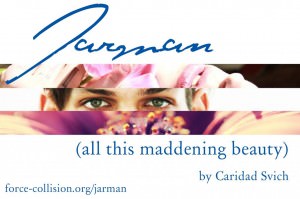For as long as there have been movies, theater artists have tried to integrate film with live performance. Something about celluloid (these days, video) seems to inspire theater artists to break the fourth wall by putting up a projection screen instead. Whether motivated by cinematic vision or cinema envy or both, this mixed-media approach tends to have mixed results. Mikhail Baryshnikov’s multimedia touring production Man in a Case is a case in point. Storytelling, a sine qua non of theater for eons, doesn’t readily leap back and forth, much less bridge the gap or blur the line, between the forms. That’s not to say meaningful merger of the two media can’t be done and done well—but the bar is very high.
The production cryptically titled Jarman, (all this maddening beauty) just opened by force/collision at Atlas Performing Arts Center, valiantly and defiantly takes up the challenge. Billed as “a premiere work-in-progress performance,” the piece features live onstage in real time solely the engaging and versatile John Moletress (who also directed, with Jacob Janssen associate director), plus 14 others (A.J.Coley, Ryan Patrick Welsh, Elizabeth Van Den Berg, Tony Tsendeas, Jefferson Farber, Pu$$y Noir, Joshua Limbaugh, Stephen Benedicto, Scott Frost, Christin Meador, Matthew Cumbie, Jeffrey Brady, Dean Barnes, Craig Souza) who appear in little clothing in artfully crafted videos by Filmmaker Benjamin Carver.
The pretext for the text by Obie-winning playwright Caridad Svich is an homage to Derek Jarman, the exuberantly imagistic filmmaker whose bold influence on queer and indie cinema is getting a fresh round of recognition on the anniversary of his death in 1994 from AIDS. (If you’ve never heard of Jarman, or even if you have, I recommend force/collision’s terrific online background material about the artist and the production.)
The piece begins simply as Moletress addresses the audience directly (speaking a text he also delivers as voiceover for a striking video by Carter released to promote this production):
This is the story of a boy
This is the story of a boy who made pictures
In a place called England
This is the story of that same boy when he was a man
And kept making pictures, and books, and gardens too
This boy became an artist
…
This is the story of a man who made pictures
And one day got sick, very sick
From a terrible plague that was goin’ ’round
This is the story of an artist who went blind
But even in his last days, kept making
Pictures in his head, beautiful pictures
Do not be deceived by the promise of linear storytelling in those moving words, however, because formally this show is a wild melange of language, movement, sound, and image. How wild? Well, to give you some idea: About 30 minutes in we get Moletress twerking in Margaret Thatcher mask and Iron Lady drag to Madonna’s “Girl Gone Wild” whilst onscreen on either side of the stage we can ogle a go-go boy shaking his booty in Great Britain-branded undies. Not long after that, Moletress with his back to the audience heists up his Thatcher skirt and feigns a pee on a small gravel garden or gravesite around which posies grow. At another point Moletress—channeling Jarman as if to tip us off—puts a megaphone to his mouth and shouts: “Fuck narrative!”
At that the show succeeds.
Moletress becomes three individuated characters during the evening: Jarman himself, a younger man who’s discovering Jarman’s oeuvre and is in awe of it, and the male lover who in Jarman’s last years became his caretaker. Throughout there are references to Jarman’s life and work, his queer esthetic and gay-rights activism. But there’s no sense of biographical continuity. And don’t expect much plot beyond that pissoir gravel patch.
There are some brilliant visuals, however, not least Lisi Stoessel’s set, David Crandall’s projections (he also did the dancefloor-ready soundtrack), and Jedidiah Roe’s lighting. When Moletress from behind a projector reaches his hand in shadow as if to caress a beautiful young man in the video, for instance, or when Moletress abruptly smears blue paint over his eyes at the point Jarman goes blind, the effect is chilling. At times like these, the stagecraft and subject seem as one. At other times the show slows and loses focus, notably during several long passages when Moletress is off stage and our attention is meant to be sustained by audiovisual effects alone. That didn’t work for me (though in fairness I’m no audiophile or cineaste).
Decidedly a work-in-progress—with a talkback for audience input afterward the night I attended—this theater/video hybrid nonetheless warrants serious attention. Even as the show’s current iteration lacks the illuminating lucidity of this discussion of it by Moletress and Svich, and even as its visuals lack the evocative beauty of Carver’s videos, the company’s ambition is amazing: to find the theatrical correlative for a visionary filmmaker’s unique way of seeing that is as stunning and unforgettable to behold.
They’ve only just begun.
Running Time: 75 minutes, without an intermission.
Jarman (all this maddening beauty) runs through April 27, 2014 at Atlas Performing Arts Center- 1333 H Street, NE, in Washington, DC. Purchase tickets online.





